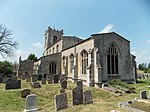Grantham and Stamford (UK Parliament constituency)
Constituencies of the Parliament of the United Kingdom established in 1997Parliamentary constituencies in LincolnshirePolitics of GranthamSouth Kesteven District

Grantham and Stamford is a constituency in Lincolnshire represented in the House of Commons of the UK Parliament since 2019 by Gareth Davies, a Conservative.Under the 2023 Periodic Review of Westminster constituencies, the constituency will be subject to major boundary changes, with Stamford being included in the re-established Rutland and Stamford constituency. The seat will be renamed Grantham and Bourne, to be first contested at the next general election.
Excerpt from the Wikipedia article Grantham and Stamford (UK Parliament constituency) (License: CC BY-SA 3.0, Authors, Images).Grantham and Stamford (UK Parliament constituency)
B1176, South Kesteven Swinstead
Geographical coordinates (GPS) Address Nearby Places Show on map
Geographical coordinates (GPS)
| Latitude | Longitude |
|---|---|
| N 52.8 ° | E -0.5 ° |
Address
B1176
NG33 4PB South Kesteven, Swinstead
England, United Kingdom
Open on Google Maps











